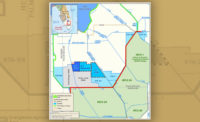A component of CERP, approved in 2000 by Congress, was a plan for 333 aquifer storage and recovery wells “to capture flows that would otherwise be lost to tide in the St. Lucie and the Caloosahatchee rivers,” says June Mirecki, senior hydro-geologist with the Corps of Engineers’ Jacksonville, Fla., District.
An ASR system consists of at least one well, surface treatment facilities and a way to take water from a surface water body into the facilities and then return it.
CERP’s ASR wells are 5 million to 15 million gallons per day (mgd) and 600 ft to 1,200 ft deep. The well is drilled into the upper Floridan Aquifer, which underlies all of Florida and parts of four other states.
Water for storage will be drawn from a river, canal or impoundment, Mirecki says. After treatment to drinking-water quality, it will be injected into the aquifer at 8 cu ft per second. When necessary, the stored water can be pumped to the surface to flood the ecosystem.
A major focus of the ASR regional study was a “very significant regional groundwater-flow modeling effort,” Mirecki says. The regional study determined that the aquifer could accommodate 131 5-mgd wells, located primarily around Lake Okeechobee.
The principal finding was that the technology has no fatal flaws, says Van Lent. “That’s a very important conclusion,” he says. “They did a lot of good work. It confirmed that this can be one of the tools in the water management toolbox.”
Water management is the key to successful ecosystem restoration, Van Lent says. But ASR has shrunk to 131 wells from 333.
“It won’t be large enough now to do the job by itself. This alone should trigger a contingency plan,” he says.








